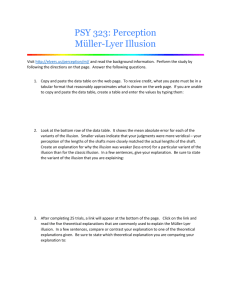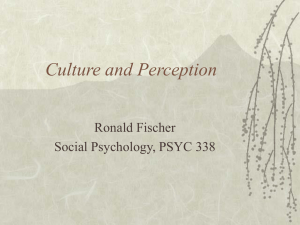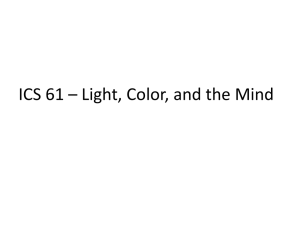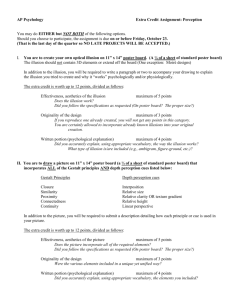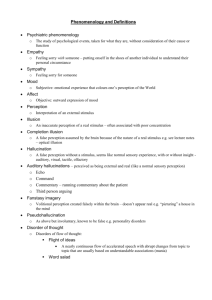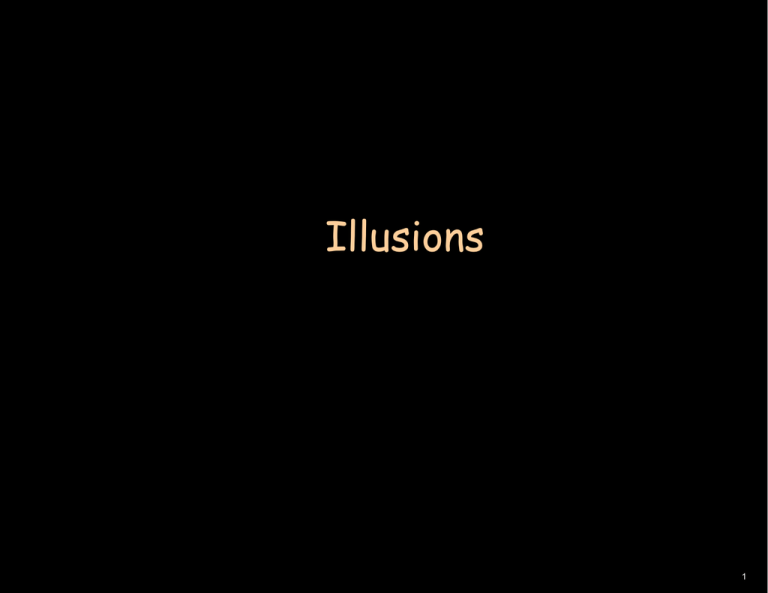
Illusions
1
A re-examination of the Hermann grid illusion
Peter H. Schiller
Image is in public domain.
2
The most widely cited theory
purported to explain the illusion:
Figure removed due to copyright restrictions.
Please see lecture video or Schiller PH, Carvey CE (2005). "The
Hermann Grid Illusion Revisited." Perception 34 (11): 1375–97.
Due to antagonistic center/surround organization, the activity of
ON-center retinal ganglion cells whose receptive fields fall into the
intersections of the grid produces a smaller response than those
neurons whose receptive fields fall elsewhere.
3
4
The effect is not size dependent
Figure removed due to copyright restriction.
Please see lecture video or Schiller PH, Carvey CE (2005). "The
Hermann Grid Illusion Revisited." Perception 34 (11): 1375–97.
5
Illusion is less pronounced when display is rotated 45 degrees
Figure removed due to copyright restriction.
Please see lecture video or Schiller PH, Carvey CE (2005). "The
Hermann Grid Illusion Revisited." Perception 34 (11): 1375–97.
6
Differently oriented vertical and horizontal lines reduce illusion
Figure removed due to copyright restriction.
Please see lecture video or Schiller PH, Carvey CE (2005). "The
Hermann Grid Illusion Revisited." Perception 34 (11): 1375–97.
7
Serrated edges reduce illusion
8
The center-surround antagonism produced in ON-center ganglion cells is similar
for the four displays but they induce notable differences in the illusory effect
ON
ON
ON
ON
9
Smudges are seen on the left where gray lines are in front and
are not seen or the right where white lines are in front.
Figure removed due to copyright restriction.
Please see lecture video or Schiller PH, Carvey CE (2005). "The
Hermann Grid Illusion Revisited." Perception 34 (11): 1375–97.
10
Color of smudges is defined by which set of lines is in front. On left
color lines are in front and smudges have the same color. On right
the white lines are in front and the smudges are weakly darker gray.
11
The illusion is reduced at isoluminancde
Figure removed due to copyright restriction.
Please see lecture video or Schiller PH, Carvey CE (2005). "The
Hermann Grid Illusion Revisited." Perception 34 (11): 1375–97.
12
Retinal ganglion cell receptive field layout at an eccentricity of 5 degrees
Figure removed due to copyright restriction.
Please see lecture video or Schiller PH, Carvey CE (2005). "The
Hermann Grid Illusion Revisited." Perception 34 (11): 1375–97.
13
S1 cell theory
Figure removed due to copyright restriction.
Please see lecture video or Schiller PH, Carvey CE (2005). "The
Hermann Grid Illusion Revisited." Perception 34 (11): 1375–97.
14
The Lingelbach scintillating grid illusion
Figure 1. Schrauf, Michael, Bernd Lingelbach, et al. "The Scintillating Grid Illusion." Vision Research 37,
no. 8 (1997): 1033-8. Courtesy of Elsevier, Inc., http://www.sciencedirect.com. Used with permission.
15
Image by MIT OpenCourseWare.
16
17
Image by MIT OpenCourseWare.
18
Image by MIT OpenCourseWare.
19
Image by MIT OpenCourseWare.
20
21
22
Image is in public domain.
23
A
B
C
Image is in public domain.
24
Image is in public domain.
25
Image is in public domain.
26
Image is in public domain.
27
Image is in public domain.
28
Image is in public domain.
29
A
B
1
1
2
2
Image is in public domain.
30
Image is in public domain.
31
The four circles illusion
Baingio Pinna and Lothar Spillman
Handout
32
Pinna, Baingio, and Richard L. Gregory. "Shifts of Edges and Deformations of Patterns." Perception 31,
no. 12 (2002): 1503. © Pion Ltd. All rights reserved. This content is excluded from our Creative
Commons license. For more information, see http://ocw.mit.edu/help/faq-fair-use/.
The four circles illusion
Baingio Pinna and Lothar Spillman
Muller-Lyer illusion
Image is in public domain.
37
Muller-Lyer illusion
38
Muller-Lyer illusion
39
40
Motion illusions
41
Courtesy of Akiyoshi Kitaoka. Used with permission.
42
Image removed due to copyright restrictions.
http://www.georgemather.com/MotionDemos/MAEQT.html
43
Limitations and ambiguities in perception:
Figure/ground relationships
44
a
b
45
a
b
46
Image is in public domain.
47
Image is in public domain.
48
Image is in public domain.
49
Image is in public domain.
50
The Road to Salvation
When you get to a fork
in the road, take it! YB
51
Image removed due to copyright restrictions.
Please see lecture video.
52
King Minos' wife was
Pasiphae who bore the
Minotaur after having
intercourse with a bull.
The Greek key motif
Basis: The myth of the labyrinth
that imprisoned the Minotaur
This motif, supposedly symbolic of
democracy, graces some of the walls
in the US senate building
King Minos had Deadalus
build a Labyrinth in which
the Minotaur was housed
King Minos and Pasiphae
also had a daugher
named Ariadne, who
helped Theseus kill
the Minotaur by giving
him a spool of thread
so he would not get
lost in the labyrinth.
Daedalus and his son
Icarus were imprisoned
by King Minos. To
escape, Daedalus
fashioned wings made
of feather and wax.
Icarus flew too close
to the sun, which melted
the wax and he fell to
his death.
53
Courtesy of Jastrow on Wikimedia Commons. Image is in public domain.
54
Image removed due to copyright restrictions.
Please see lecture video.
55
Visual Prosthetics
56
A. What aspects of vision are most desirable to recover with a prosthetic device?
1. Pattern perception
2. Motion perception
3. Depth perception
B. Problems and issues:
1. Type of prosthetic device
2. What brain area should be the target for the device?
3. What is the longevity of any selected prosthetic device?
57
90
5
4
3
Lunate Sulcus
2
Central Sulcus
1
0
180
ve
rti
ca
l
270
hor
izon
8
ta
fovea
76
5 4
3
2
1
fovea
V1
Image by MIT OpenCourseWare.
58
Present two visual targets
Present one visual target and stimulate
Vary the contrast of the visual stimulus not in the receptive field
59
Present two visual targets
Present one visual target and stimulate
Vary the size of the visual stimulus not in the receptive field
60
Percent bottom target choice
Two visual targets
targets
Contrast series
100
90
80
70
60
50
40
30
20
10
0
RF
N = 40 trials per point
Eccentricity = 3.4 deg
-7
-6
-5
-4
-3
-2
-1
0
1
2
3
4
5
6
Percent target contrast difference
Size series
100
90
80
70
60
50
40
30
20
10
0
RF
N = 40 trials per point
-15
-10
-5
0
5
10
15
Size diameter difference in minutes
Courtesy of National Academy of Sciences, U. S. A. Used with permission.
Source: Schiller, Peter H., Warren M. Slocum, et al. "New Methods Devised Specify the Size and Color of the Spots
Monkeys See when Striate Cortex (area V1) is Electrically Stimulated." Proceedings of the National Academy of
Sciences 108, no. 43 (2011): 17809-14.Copyright © 2011 National Academy of Sciences, U.S.A.
61
Percent choice at electrical stimulation site
One visual target paired with electrical stimulation
100
90
80
70
60
50
40
30
20
10
0
120uA
Contrast series
90uA
60uA
RF
Henk, Jul, 05
2
Eccentricity = 3.4 deg
4
6
8
10
12
14
16
Percent target contrast
Size series
100
90
80
70
60
50
40
30
20
10
0
5
10
15
20
25
Target size in minutes
Courtesy of National Academy of Sciences, U. S. A. Used with permission.
Source: Schiller, Peter H., Warren M. Slocum, et al. "New Methods Devised Specify the Size and Color of the Spots
Monkeys See when Striate Cortex (area V1) is Electrically Stimulated." Proceedings of the National Academy of
Sciences 108, no. 43 (2011): 17809-14.Copyright © 2011 National Academy of Sciences, U.S.A.
62
Using currents of 20 to 120 microamps at
eccentricities between 2.5 and 3.5 degrees,
the contrast of the visual percept created
in monkeys is 6 to 12% and the size is
between 15 and 20 minutes of visual angle.
63
Percent contrast
75%
40%
Contrast =
17%
A-B
A+B
8%
X 100
64
The spatial arrangement of electrode arrays
65
Figure removed due to copyright restrictions.
Please see lecture video or Figure 1 of Schiller, Peter H., and Edward
J. Tehovnik. "Visual Prosthesis." Perception 37, no. 10 (2008): 1529.
66
Figure removed due to copyright restrictions.
Please see lecture video or Figure 4 of Schiller, Peter H., and Edward
J. Tehovnik. "Visual Prosthesis." Perception 37, no. 10 (2008): 1529.
67
Figure removed due to copyright restrictions.
Please see lecture video or Figure 5 of Schiller, Peter H., and Edward
J. Tehovnik. "Visual Prosthesis." Perception 37, no. 10 (2008): 1529.
68
Figure removed due to copyright restrictions.
Please see lecture video or Figure 6 of Schiller, Peter H., and Edward
J. Tehovnik. "Visual Prosthesis." Perception 37, no. 10 (2008): 1529.
69
Figure removed due to copyright restrictions.
Please see lecture video or Figure 7 of Schiller, Peter H., and Edward
J. Tehovnik. "Visual Prosthesis." Perception 37, no. 10 (2008): 1529.
70
Figure removed due to copyright restrictions.
Please see lecture video or Figure 9 of Schiller, Peter H., and Edward
J. Tehovnik. "Visual Prosthesis." Perception 37, no. 10 (2008): 1529.
71
Figure removed due to copyright restrictions.
Please see lecture video or Figure 11 of Schiller, Peter H., and Edward
J. Tehovnik. "Visual Prosthesis." Perception 37, no. 10 (2008): 1529.
72
camera
monitor
73
Figure removed due to copyright restrictions.
Please see lecture video or Figure 10 of Schiller, Peter H., and Edward
J. Tehovnik. "Visual Prosthesis." Perception 37, no. 10 (2008): 1529.
74
Scheme for mimicking a prosthetic device: Intercell comparator arrangement
CAMERA UNIT
camera cell
256 cells. Each cell connects with
corresponding region in display unit. The
size of the regions activated in the display
unit vy each camera cell is as shown.
If a = b = c = d there is no response
If the four are not equal there is a
response the magnitude of which
increases with increasing difference
a b
c d
Each camera unit is about 40 by 40 pixels.
a
b
c
d
e
DISPLAY UNIT
no activation
activation
75
Summary:
1. Research on visual prosthetics is in its infancy. A great deal of basic
research is needed before such a device can become effective.
2. The brain area that holds considerable promise for a prosthetic device based
electrical microstimulation is V1.
3. A prosthetic device for electrical stimulation of V1 must take intoaccount
the magnificagtion factor.
4. There is no unitary explanation for the great many visual illusions extant.
5. The most popular theory explaining the Hermann grid illusion based on the
center/surround organization of retinal ganglion cells is incorrect. A more
likely theory is the one that assumes that V1 cells are involved.
6. Retinal adaptation processes can explain illusions based on after-effects.
7. Many illusions disappear under isoluminant conditions.
8. There are no viable theories that explain illusions based on figure/ground
relationships.
76
MIT OpenCourseWare
http://ocw.mit.edu
9.04 Sensory Systems
Fall 2013
For information about citing these materials or our Terms of Use, visit: http://ocw.mit.edu/terms.

